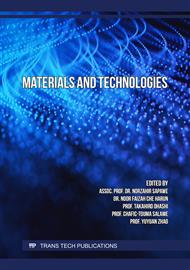[1]
X. Sun, L. Li, X. Xu, G. Song, et al: Preparation of hydrophobic SiO2/PTFE sol and antireflective coatings for solar glass cover (Optik, 2020).
DOI: 10.1016/j.ijleo.2020.164704
Google Scholar
[2]
M. Mozumder, A. Mourad, H. Pervez, and R. Surkatti: Recent developments in multifunctional coatings for solar panel applications: A review (Solar Energy Materials and Solar Cells, 2019).
DOI: 10.1016/j.solmat.2018.09.015
Google Scholar
[3]
W. Stöber, A. Fink and E. Bohn, J. Colloid: Controlled Growth of Monodisperse Silica Spheres in the Micron Size Range (J. Colloid Interface Sci., 1968).
DOI: 10.1016/0021-9797(68)90272-5
Google Scholar
[4]
Y. Xu, C. Peng, C. Xin, and J. Wu: Preparation of silica antireflective films for solar energy application (Materials Letters, 2013).
DOI: 10.1016/j.matlet.2012.12.013
Google Scholar
[5]
L. Ye, S. Zhang, Q. Wang, et al: Mechanically stable single-layer mesoporous silica antireflective coating on solar glass (RSC Adv., 2014).
DOI: 10.1039/c4ra05309e
Google Scholar
[6]
X. Meng, Y. Wang, H. Wang, J. Zhong, and R. Chen: Preparation of hydrophobic and abrasion-resistant silica antireflective coatings by using a cationic surfactant to regulate surface morphologies (Solar Energy, 2014).
DOI: 10.1016/j.solener.2013.12.038
Google Scholar
[7]
X. Zhang, H. Ye, B. Xiao, et al: Sol−Gel Preparation of PDMS/Silica Hybrid Antireflective Coatings with Controlled Thickness and Durable Antireflective Performance (The Journal of Physical Chemistry, 2010).
DOI: 10.1021/jp106192z
Google Scholar
[8]
Y. Yuan, G. Yan, S. H. Huang, and R. J. Hong: Preparation of hydrophobic SiO2/PMHS sol and ORMOSIL antireflective films for solar glass cover (Solar Energy, 2016).
DOI: 10.1016/j.solener.2016.01.060
Google Scholar
[9]
X. Huang, Y. Yuan, S. Liu, W. Wang, and R. Hong: One-step sol-gel preparation of hydrophobic antireflective SiO 2 coating on poly(methyl methacrylate) substrate (Materials Letters, 2017).
DOI: 10.1016/j.matlet.2017.05.028
Google Scholar
[10]
W. Lin, Y. Sun, J. Zheng, et al: Surface Modification of Sol-Gel Silica Antireflective Coatings by F-PMHS: A Simple Method for Improvement of Amphiphobicity (Coatings, 2018).
DOI: 10.3390/coatings8020057
Google Scholar
[11]
R. Patterson, A. Kandelbauer, U. Müller, and H. Lammer: Crosslinked Thermoplastics. Handbook of Thermoset Plastics (2014).
DOI: 10.1016/b978-1-4557-3107-7.00017-8
Google Scholar
[12]
X. Zhang, B. Xia, H. Ye, et al: One-step sol–gel preparation of PDMS–silica ORMOSILs as environment-resistant and crack-free thick antireflective coatings (Journal of Materials Chemistry, 2012).
DOI: 10.1039/c2jm31005h
Google Scholar
[13]
S. Ahangarani, N. Lari, and A. Shanaghi: A novel route to prepare hydrophobic and durable antireflective hybrid silica coating by sol-gel method (Protection of Metals and Physical Chemistry of Surfaces, 2016).
DOI: 10.1134/s2070205116030175
Google Scholar
[14]
A. Pan, H. Lu, L.Z. Zhang: Experimental investigation of dust deposition reduction on solar cell covering glass by different self-cleaning coatings (Energy, 2019).
DOI: 10.1016/j.energy.2019.05.223
Google Scholar
[15]
H. K. Raut, V. Ganesh, A. Nair, et al: Anti-reflective coatings: A critical, in-depth review (Energy & Environmental Science, 2011).
Google Scholar
[16]
T. Galy, M. Marszewski, S. King, et al: Comparing methods for measuring thickness, refractive index, and porosity of mesoporous thin films (Microporous and Mesoporous Materials, 2019).
DOI: 10.1016/j.micromeso.2019.109677
Google Scholar
[17]
W. Glaubitt and P. Löbmann: Antireflective coatings prepared by sol–gel processing: Principles and applications (2012).
DOI: 10.1016/j.jeurceramsoc.2012.02.032
Google Scholar
[18]
A. M. Pires, M. Braga, and R Ruther: Performance assessment of bare and anti‐reflective coated CdTe photovoltaic systems in comparison to multicrystalline Si in Brazil (Progress in Photovoltaics: Research and Applications, 2021).
DOI: 10.1002/pip.3446
Google Scholar



